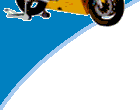




| Kit Details |
First thing to do was decide on the paint scheme for the RoadStar. I don't like the 'Yamaha Black' colours but the 'Yamaha Cherry Red' scheme of cream/red looked quite nice. Wanting to be a bit different, I immediately thought of a cream/turquoise that I've seen on classic Harleys. So I used Tamiya's Coral Blue (TS-41) instead of the Metallic Red (TS-18).
| Paints Actually Used | |
| Tamiya | TS-7, 14, 17, 41 X-6, 7, 18, 26, 27, 31(Enamel) XF-16, 56, 63 |
| Model Master Metallizer | BAP, BDAG, BEX, NBA, NBS |
| Model Master Acryl | Gloss Clear |
| Paint Substitutions | |
| X-11 | Model Master Chrome Silver |
| X-18 | Muted Black (X-18:3 + XF-63:1) |
| XF-16 | Model Master Non-Buffing Aluminium (NBA) |
Note: there is a lot of chrome in this kit. Always wear latex or cotton gloves to keep these pieces free of fingerprints.
![]()
Body Work
Although I didn't, you should try to prepare, paint and decal the bodywork as
soon as possible. Then you can let the paint dry thoroughly while working on the
rest of the kit. Since I used the cream tank tear drops, I needed to use decal
solutions to get the tear drops to conform to the convex sides of the tank. I
used Micro Scale's Micro Set and the more potent Micro Sol.
After the decals were applied, I clear coated all the bodywork with two coats of Model Master Acryl Gloss Clear. This 'clear' doesn't look clear in the bottle and it actually darkened the colours of the Racing White and Coral Blue. Usually this is undesirable, but it gave the colours more of an aged and classic look.
![]()
Step #1
Masked the left engine cover (E20) and sprayed with BDAG instead of XF-56.
Step #2
The cylinder heads were painted with NBA.
Step #3
Plumbers hose clamps were added to the oil line from B6 to B15.
Step #4
I painted the frame with TS-14 rather than X-1. Make sure you add the side stand bracket now. Once the engine is in the frame its difficult,
if not impossible, to add the screw.
Step #5
Nothing note worthy
Step #6
Nothing note worthy
Step #7
In order to paint the drive belt, I made disks of masking tape to mask face of the pulleys.
Unfortunately, it wasn't until final assembly that I noticed that most the carefully painted drive belt would be hidden under the
belt guards.
Step #8
Test fitting the swingarm pieces confirmed that it can be assembled before adding the drive belt and wheel. The bolt heads on the caliper
were counter sunk to simulate Allen heads. The center of the brake disc was masked off and braking
surface was painted with NBS.
Step #9
I brush painted the belt cover E25 since it was to difficult to mask.
![]()
Step #10
Heat formed the spark plug wires for a better fit.
Even though I choose a two colour paint scheme, I assembled the rear fender before painting.
Step #11
It was easier to masked and paint the mounting bracket on E11 before assembling the exhaust.
Step #12
Heat formed the spark plug wires for a better fit.
Step #13
The bolt heads on the calipers were counter sunk to simulate Allen heads. The chrome was stripped from the forks and the lower ends
repainted with NBA. The calipers were painted with NBS. D10 was stripped and painted with BAP and buffed.
Step #14
The parts D12 were left in their satin chrome finish. D13 was stripped and painted with NBA.
The centers of the brake disc were masked off and braking surfaces were painted with NBS. The kit tubing was used for the brake
lines and heated formed to have they routed properly.
Step #15
Studs on B4 were removed and holes drilled for fine wire throttle cables. The stud on A6 was removed and a hole drilled for a fine wire
clutch cable. The handle bar was masked off and the handlebar brackets painted with NBA and sealed.
Step #16
The speedometer face was glued in with Kristal Klear. I had to use the stronger Microscale Micro Sol decal solution
to get the fuel tank teardrop decals to conform to the fuel tank sides.
Step #17
Fine black coated wire was used for the throttle and clutch cables. The kit tubing was used for the brake lines.
Step #18
The rubber pads on the foot boards were left in the black plastic. I thought it had the look of 'Armour All'ed rubber.
Step #19
Nothing note worthy
Step #20
Wrinkles added to the upper portion of the seat and the passenger
cushion. Before adding the foot boards, I placed the RoadStar on the clear stand provided. This ensured the bike was perfectly vertical as
I attached and supported the foot boards.
 |
|||||||||||||||
|
|||||||||||||||
 Home - News - Tips - Gallery - Workshop - Kits - Links - What's New? - Site Index |



